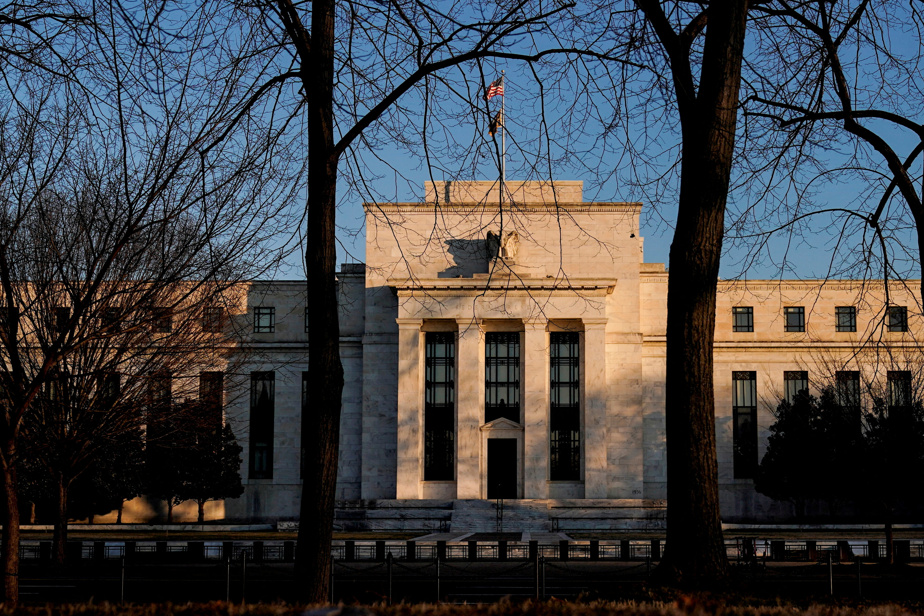(Washington) Status quo at the Fed which, as expected, left its rates as they are on Wednesday, and plans to lower them several times in 2024, taking note of the slowdown in economic activity, despite inflation still “too much high”.
The American central bank kept its rates in a range of 5.25 to 5.50%, the highest in 22 years, a decision taken unanimously, according to a press release published after the meeting.
Its managers mainly anticipate three or four reductions next year, to bring them to 4.6% at the end of 2024.
The speech was well received on Wall Street, where the Dow Jones stock index jumped 1.35% to a record high, celebrating the status quo on rates and the possibility of future cuts amid falling bond yields. .
“Inflation has fallen since its peak, without a significant increase in unemployment. This is very good news,” emphasized Fed President Jerome Powell in the introduction to his press conference on Wednesday.

PHOTO PETE MAROVICH, THE NEW YORK TIMES
Jerome Powell, Chairman of the Fed
Before dampening his enthusiasm: “but inflation remains too high. The progress being made to bring it down is not assured, and the path is uncertain.”
In its updated forecasts, however, the Fed sees inflation slowing a little faster than expected, falling to 2.4% at the end of 2024 (compared to 2.5% anticipated in previous forecasts, in September).
But we will have to wait until 2026 to see it return to the long-awaited level of 2.0%.
As for growth, this year it will be stronger than initially anticipated, at 2.6% (compared to 2.1%), but should slow down more than expected next year, to 1.4% (compared to 1.5 %), and then accelerate again.
No change, however, for the unemployment rate, expected at 3.8% this year, and 4.1% in 2024.
Policymakers predict the unemployment rate will reach 4.1% next year, up from 3.7% currently, which would remain a historically low level. They forecast modest economic growth of 1.4% next year and 1.8% in 2025.
The Fed’s decision penalized the dollar, but caused oil to rebound.
Slowed growth
“Recent indicators suggest that growth in economic activity has slowed since its solid pace in the third quarter,” commented the Fed’s monetary policy committee, the FOMC, after the meeting that began Tuesday morning.
The president of the institution, Jerome Powell, however, remained cautious: “although those responsible [de la Fed] consider it unlikely that it would be appropriate to raise rates again, however, they have not ruled out the possibility either,” he warned.
With a more encouraging tone than expected, he still recognized that the monetary committee had discussed the start of a timetable for rate cuts, something he had until now dismissed out of hand.
“While we believe rates are at or near their peak for this cycle, the economy has surprised forecasters in multiple ways,” he commented.
The Fed has raised rates 11 times since March 2022 to curb high inflation. However, it has not touched it since July, in order to observe the effects of these increases, and to avoid plunging the American economy into recession.
“Soft landing”
After soaring to levels not seen since the early 1980s, inflation is now on an upward slope. It slowed to 3.1% year-on-year in November, according to the CPI index, and to 3.0% in October according to the PCE index, the one that the Fed wants to reduce to 2% – and for which data from November have not yet been published.
The rise in wages, although less strong than a few months ago, remains too high to allow inflation to return to the desired level, however, warned Jerome Powell.
With the fall in inflation, however, wage gains are higher than the rise in prices, and allow an increase in household purchasing power.
“By the end of 2024, the inflation index will surely start with the number 2”, that is to say that it will be between 2.00 and 2.9%, the Secretary of State anticipated on Wednesday. Treasure, Janet Yellen, on CNBC.
And the world’s largest economy seems well on its way to a “soft landing”, a drop in inflation without a recession, she estimated.
“The employment situation still looks excellent and inflation is falling very quickly. And that’s exactly what we promised,” Chicago Fed President Austan Goolsbee also recently welcomed.
